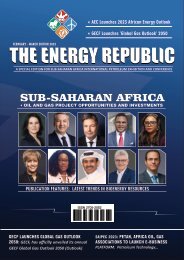OGRepublic August Edition
This edition is focused on Shell Nigeria Exploration and Production Company 'Digital Twin' for its Bonga FPSO.
This edition is focused on Shell Nigeria Exploration and Production Company 'Digital Twin' for its Bonga FPSO.
Create successful ePaper yourself
Turn your PDF publications into a flip-book with our unique Google optimized e-Paper software.
AMERICAN PETROLEUM INTERVIEW
Similarly, for LNG importing countries, we’re
looking at how coal-to-gas switching in their
power generation and industrial sectors can
reduce their GHG emissions. For example, we
are working on completing life-cycle analyses
(LCA) that take into account emissions across
the whole value chain—from wellhead to
burner tip. We released our GHG emissions LCA
for LNG exports in the power generation sector
last July.
One of the main findings was that using U.S.
LNG rather than coal for electricity generation
produces on average 50.5% fewer GHG
emissions in importing countries ranging from
China, Germany, and India.
We just completed a soon-to-be-released
follow-up report covering the LCA for LNG use
in the industrial sector, and the findings
indicate that coal-to-gas switching in China,
India, and Vietnam could reduce GHG
emissions by 26.5% on average.
This is an important finding given that the
International Energy Agency and many other
entities project that a very sizable percentage
of total global gas demand growth over the
next decade or so will be driven by industrial
demand in India and other Asian markets.
OGR: As an industry expert, what is the
pathway for a successful energy transition?
Meyer: I think there are two important points
to keep in mind. First, there will not be a onesize-fits-all
path for countries to take. Every
country has different considerations to take
into account. For example, what are their
natural resource endowments? Are they
energy importers or exporters? How rapidly is
their economy growing? What’s the state of
energy infrastructure in the country? These
questions and others will influence which
strategy any given country selects in pursuing a
lower-carbon energy future.
Second, while there is no single pathway, it
seems clear that an open-minded, all-of-theabove
approach is going to be particularly
helpful, especially in developing future
technologies that can help drive even deeper
emissions reductions.
One example is carbon capture, utilization, and
storage (CCUS). We see CCUS as a critical
technology that ensures the energy transition
will benefit from the reliability and flexibility of
natural gas, especially as an enabler and
complement to rising variable renewable
energy generation.
Dustin Meyer, Vice President for Natural Gas
Market, at American Petroleum Institute (API)
Hydrogen is another example--including
hydrogen made using natural gas in
combination with CCUS technology.
There’s so much good work and investment
going into these technologies, but we’re just
getting started and it’d be particularly
misguided to sideline any technology that will
help reduce emissions.
But to be clear, a lot of countries don’t
necessarily have the luxury to wait 5-10 years
for new carbon-free technologies to reach a
commercial scale. They need to meet rapidly
rising energy demand today.
So, I believe countries should look at all
available technologies and fuel sources that can
help them meet their emissions reductions
goals while also meeting demand, and I think in
a lot of instances, natural gas is going to be a
great choice to do so.
OGR: What are your opinions for developing
countries to unlocking their natural gas
resources as a viable source of clean energy?
Meyer: One of the biggest benefits that U.S.
LNG exports afford is increased energy security
for our trading partners, but certainly, energy
security can also come from countries
developing their resources.
Either way, in emerging economies, the future
role of natural gas goes far beyond the power
sector. It can play a major role in building out
industrial and manufacturing capacity, which of
course has tremendous economic and
employment benefits.
Increased access to natural gas can also help
reduce mortality from indoor air pollution,
which is estimated to cause 1.6 million
premature deaths worldwide each year
according to the WHO.
Already, the transition from cooking with
traditional biomass to natural gas has
significantly reduced air pollution in China,
India, Indonesia and several other countries. So,
whether the gas is imported or produced
domestically, the opportunity is significant.
OGR: What's your projections for the LNG
industry in 2021 going forward?
Meyer: The top trend to watch in 2021 will be
what happens with natural gas prices. Last
summer saw historically low prices and the
convergence of the major price indices for Asia,
Europe, and the U.S.
Then, at the very end of last year and in the first
weeks of this year, prices spiked to historically
high levels, the result of many factors including
a cold snap in large parts of Northeast Asia.
Since then, prices have of course moderated,
but they are still fairly robust.
This recovery in natural gas prices is significant
because, just a few months ago, those sceptical
of the long-term viability of the U.S. LNG
industry pointed to very low summer prices as
validation of their doubts—not just about LNG,
but about future demand for natural gas more
generally. But the tightening market has quickly
quieted that argument.
Going forward, robust prices could very well
lead to a re-emergence of contracting to
underpin the new export capacity that will
surely be required to meet rising long-term
demand and in fact, this coincides with a lot of
countries building out their gas import, storage,
and distribution infrastructure.
The combination of these two developments,
the recovery in gas prices and a re-emergence
of interest in contracting, could help push some
U.S. exporters that had delayed FID from 2020
over the line and in a position to make FID this
year, which would be great to see.
41
OIL AND GAS REPUBLIC I SPECIAL EDITION















